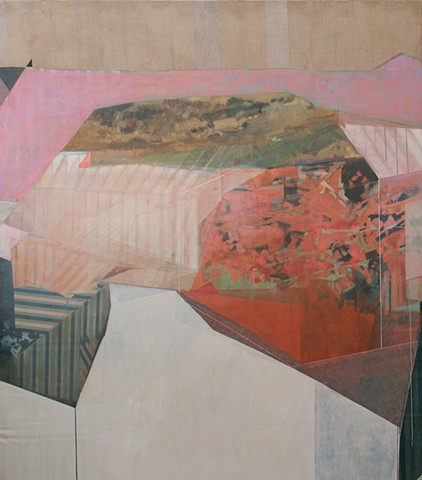ALBA NEOLITHIC
From the series ALBA NEOLITHIC
In my newest series of paintings I continue to explore the juxtaposition of nature and industry while reflecting upon my recent travels through Scotland. These works are a reflection of the dramatic and cyclical history etched into the Scottish highlands. Once a lush forest covered in trees, Scotland’s now iconic landscape of open vistas, awash in heather, is an illustration of human reinvention, appropriation and second wave conservation.
Scotland’s landscape saw a dramatic shift 5,000 years ago, during the Neolithic Era, when a climate shift rendered the once dense forests largely uninhabitable for native trees. As agriculture slowly developed among local populations, land was further cleared for grazing livestock. By the early 1900’s the majority of forestland had been razed by the human hand for farming and ship-building. In the early 1930’s less than 10% of Scotland’s forest remained. Industry had reinvented an already shifting landscape to better serve human needs. It was World War II which brought new demands to the hills and valleys of Scotland. The United Kingdom’s need for lumber supply inspired rapid changes with the cultivation of new and controlled forests; populated with fast growing, non-native trees. Densely planted, rigid, foreign and quickly harvested- this was not the forest of Scotland’s past but a reinvention designed to best serve the immediate needs of growing world at war. Today these controlled and cultivated forest, inundated with human design, intention and oversight is less than in keeping with modern ideas of conservation. New efforts are underway to restore the indigenous forest wiped from all recent memory.
Three world are on display in Scotland today as the rolling hills, crags and moss come to head with the managed geometric forests of human invention while contrasting with the new slow-growth, organic plantings of indigenous trees meant to re-invision a lost landscape and support a forgotten wild life. The human hand can’t seem to stop altering even when attempting to re-create what was once organic.Within these works, vertical and rigid elements strike through the canvas in orderly rows. Geometric planes break the landscape into the utilitarian confines of human development and ownership. Architectual lines grow and superimpose over implied land masses as industry reacts to human need and consumption. Each of these elements penetrates the unified fields of purple and orchre evoking the undergrowth of heather and moss which is the stage of human curation.
